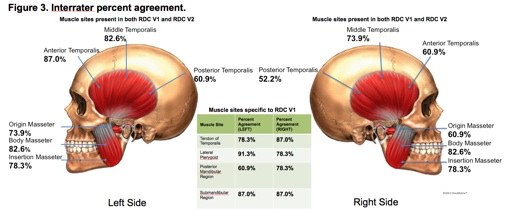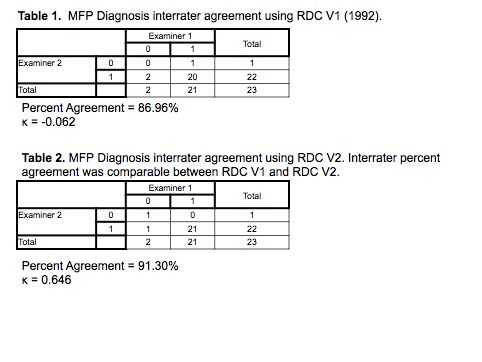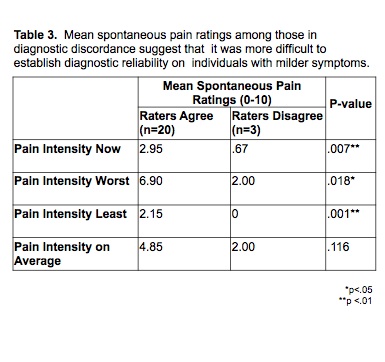Introduction:TMDs comprise a number of painful conditions affecting the muscles of mastication and TMJ. Research Diagnostic Criteria for TMDs(RDCV1, 1992) formed a model diagnostic algorithm based on clinical history and physical examination. Myofascial pain(MFP) is particularly dependent on physical examination, requiring standardized palpation across masticatory muscle sites. Recently, revised RDC-TMD(RDCV2) diagnostic algorithms have been recommended to improve validity and reliability, with several changes in the diagnostic algorithm of MFP.
Objectives :1)To determine interrater reliability of RDCV1 MFP diagnosis.2)To determine whether the 12 muscles sites retained for MFP diagnosis in RDCV2 showed better interrater reliability than the 8 muscle sites removed in RDCV2.3)To compare overall interrater reliability for MFP in RDCV1 and V2.
Methods :Diagnostic reliability data were drawn from an ongoing case-control study exploring possible mechanisms underlying MFP. Subjects were palpated by 2 clinical examiners across 20 muscle sites. Diagnosis of MFP using RDCV1 included pain upon palpation at ³3 of twenty muscle sites, while the diagnosis of MFP using RDCV2 included pain at ³1 of twelve muscle sites. Percent agreement and Kappa were calculated. Facial exams were preceded by questions relating to subjects' past and present pain severity on a scale of 0(no pain) to 10(worst pain imaginable). Independent sample t-tests were used to compare mean spontaneous pain ratings between subjects for whom there was diagnostic discordance and concordance.
Results: Percent agreement showed no difference between interrater reliability of muscle sites specific to RDCV1 and those retained in RDCV2. Diagnostic reliability for the purposes of the case-control study from which these data were drawn was found to be acceptable.
Conclusions: Among the few instances of diagnostic discordance, a pattern of relatively low mean spontaneous pain ratings suggested difficulty in establishing diagnostic reliability in individuals with milder symptoms. The high base rate of TMDs among subjects likely contributed to the low kappa values seen.
Keywords: Diagnostic Criteria, Pain and TMJ and masticatory muscles
![[ Visit AADR's Website ]](images/banner.jpg)




